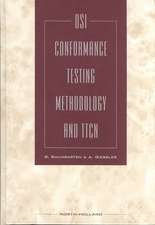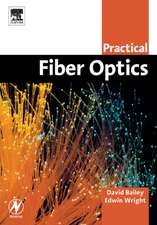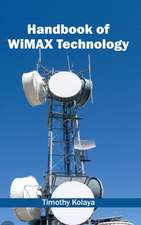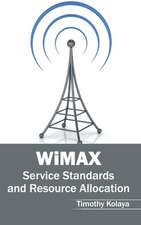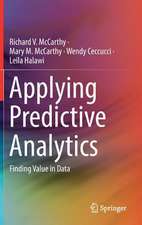Applying Predictive Analytics: Finding Value in Data
Autor Richard V. McCarthy, Mary M. McCarthy, Wendy Ceccuccien Limba Engleză Hardback – 23 dec 2021
| Toate formatele și edițiile | Preț | Express |
|---|---|---|
| Paperback (1) | 387.96 lei 43-57 zile | |
| Springer International Publishing – 24 dec 2022 | 387.96 lei 43-57 zile | |
| Hardback (1) | 428.36 lei 22-36 zile | +25.67 lei 6-12 zile |
| Springer International Publishing – 23 dec 2021 | 428.36 lei 22-36 zile | +25.67 lei 6-12 zile |
Preț: 428.36 lei
Preț vechi: 516.10 lei
-17% Nou
Puncte Express: 643
Preț estimativ în valută:
81.97€ • 85.80$ • 68.22£
81.97€ • 85.80$ • 68.22£
Carte disponibilă
Livrare economică 10-24 martie
Livrare express 22-28 februarie pentru 35.66 lei
Preluare comenzi: 021 569.72.76
Specificații
ISBN-13: 9783030830694
ISBN-10: 3030830691
Pagini: 246
Ilustrații: XV, 274 p. 287 illus., 253 illus. in color.
Dimensiuni: 155 x 235 x 24 mm
Greutate: 0.59 kg
Ediția:2nd ed. 2022
Editura: Springer International Publishing
Colecția Springer
Locul publicării:Cham, Switzerland
ISBN-10: 3030830691
Pagini: 246
Ilustrații: XV, 274 p. 287 illus., 253 illus. in color.
Dimensiuni: 155 x 235 x 24 mm
Greutate: 0.59 kg
Ediția:2nd ed. 2022
Editura: Springer International Publishing
Colecția Springer
Locul publicării:Cham, Switzerland
Cuprins
Chapter 1.- Introduction to Predictive Analytics.- 1.1 Predictive Analytics in Action.- 1.2 Analytics Landscape.- 1.3 Analytics.- 1.3.2 Predictive Analytics.- 1.4 Regression Analysis.- 1.5 Machine Learning Techniques.- 1.6 Predictive Analytics Model.- 1.7 Opportunities in Analytics.- 1.8 Introduction to the Automobile Insurance Claim Fraud Example.- 1.9 Chapter Summary.- References.- Chapter 2.- Know Your Data – Data Preparation.- 2.1 Classification of Data.- 2.1.1 Qualitative versus Quantitative.- 2.1.2 Scales of Measurement.- 2.2. Data Preparation Methods..- 2.2.1 Inconsistent Formats.- 2.2.2 Missing Data.- 2.2.3 Outliers.- 2.2.4 Other Data Cleansing Considerations.- 2.3 Data Sets and Data Partitioning.- 2.4 SAS Enterprise Miner™ Model Components.- 2.4.1 Step 1. Create Three of the Model Components.- 2.4.2 Step 2. Import an Excel File and Save as a SAS File.- 2.4.3 Step 3. Create the Data Source.- 2.4.4 Step 4. Partition the Data Source.- 2.4.5 Step 5 Data Exploration.-2.4.6 Step 6 Missing Data.- 2.4.7 Step 7. Handling Outliers.- 2.4.8 Step 8. Categorical Variables with Too Many Levels.- 2.5 Chapter Summary.- References.- Chapter 3.- What do Descriptive Statistics Tell Us.- 3.1 Descriptive Analytics.- 3.2 The Role of the Mean, Median and Mode.- 3.3 Variance and Distribution.- 3.4 The Shape of the Distribution.- 3.4.2 Kurtosis.- 3.5 Covariance and Correlation.- 3.6 Variable Reduction.- 3.6.1 Variable Clustering.- 3.6.2 Principal Component Analysis.- 3.7 Hypothesis Testing.- 3.8 Analysis of Variance (ANOVA).- 3.9 Chi Square.- 3. Fit Statistics.- 3. Stochastic Models.- 3.12 Chapter Summary.- References.- Chapter 4.- Predictive Models Using Regression.- 4.1 Regression.- 4.1.1 Classical assumptions.- 4.2 Ordinary Least Squares.- 4.3 Simple Linear Regression.- 4.3.1 Determining Relationship Between Two Variables.- 4.3.2 Line of Best Fit and Simple Linear Regression Equation.- 4.4 Multiple Linear Regression.- 4.4.1 Metrics to Evaluate the Strength of the Regression Line.- 4.3.2 Best-fit model.- 4.3.3 Selection of Variables in Regression.- 4.5 Principal Component Regression.- 4.5.1 Principal Component Analysis Revisited.- 4.5.2 Principal Component Regression.- 4.6 Partial Least Squares.- 4.7 Logistic Regression.- 4.7.1 Binary Logistic Regression.- 4.7.2 Examination of Coefficients.- 4.7.3 Multinomial Logistic Regression.- 4.7.4 Ordinal Logistic Regression.- 4.8 Implementation of Regression in SAS Enterprise Miner™.- 4.8.1 Regression Node Train Properties: Class Targets.- 4.8.2 Regression Node Train Properties: Model Options.- 4.8.3 Regression Node Train Properties: Model Selection.- 4.9 Implementation of Two-Factor Interaction and Polynomial Terms.- 4.9.1 Regression Node Train Properties: Equation.- 4. DMINE Regression in SAS Enterprise Miner™.- 4..1 DMINE Properties.- 4..2 DMINE Results.- 4. Partial Least Squares Regression in SAS Enterprise Miner™.- 4..1 Partial Least Squares Properties.- 4..2 Partial Least Squares Results.- 4. Least Angles Regression in SAS Enterprise Miner™.- 4..1 Least Angle Regression Properties.- 4..2 Least Angles Regression Results.- 4. Other Forms of Regression.- 4. Chapter Summary.- References.- Chapter 5.- The Second of the Big Three – Decision Trees.- 5.1 What is a Decision Tree?.- 5.2 Creating a Decision Tree.- 5.3 Data Partitions and Decision Trees.- 5.4 Creating a Decision Tree Using SAS Enterprise Miner™.- The key properties include:.- Subtree Properties.- 5.4.1 Overfitting.- 5.5 Creating an Interactive Decision Tree using SAS Enterprise Miner ™.- 5.6 Creating a Maximal Decision Tree using SAS Enterprise Miner ™.- 5.7 Chapter Summary.- References.- Chapter 6.- The Third of the Big Three - Neural Networks.- 6.1 What is a Neural Network?.- 6.2 History of Neural Networks.- 6.3 Components of a Neural Network.- 6.4 Neural Network Architectures.- 6.5 Training a Neural Network.- 6.6 Radial Basis Function Neural Networks.- 6.7 Creating a Neural Network using SAS Enterprise MinerÔ.- 6.8 Using SAS Enterprise MinerÔ to Automatically Generate a Neural Network.- 6.9 Explaining a Neural Network.- 6. Chapter Summary.- References.- Chapter 7.- Model Comparisons and Scoring.- 7.1 Beyond the Big.- 7.2 Gradient Boosting.- 7.3 Ensemble Models.- 7.4 Random Forests.- 7.6 Two-Stage Model.- 7.7 Comparing Predictive Models.- 7.7.1 Evaluating Fit Statistics – Which Model Do We Use?.- 7.8 Using Historical Data to Predict the Future – Scoring.- 7.8.1 Analyzing and Reporting Results.- 7.8.2 Save Data Node.- 7.8.3 Reporter Node.- 7.9 The Importance of Predictive Analytics.- 7.9.1 What Should We Expect for Predictive Analytics in the Future?.- 7. Chapter Summary.- References.- Chapter 8.- finding Associations in Data through Cluster Analysis.- 8.1 Applications and Uses of Cluster Analysis.- 8.2 Types of Clustering Techniques.- 8.3 Hierarchical Clustering.- 8.3.1 Agglomerative Clustering.- 8.3.2 Divisive Clustering.- 8.3.3 Agglomerative vs Divisive Clustering.- 8.4 Non-hierarchical clustering.- 8.4.1 K-means Clustering.- 8.4.2 Initial Centroid Selection.- 8.4.3 Determining the Number of Clusters.- 8.4.4 Evaluating your clusters.- 8.5 Hierarchical vs Nonhierarchical.- 8.6 Cluster Analysis using SAS Enterprise Miner™.- 8.6.1 Cluster Node.- 8.6.2 Additional Key Properties of the Cluster Node.- 8.7 Applying Cluster Analysis to the Insurance Claim Fraud Data Set.- 8.8 Chapter Summary.- References.- .- Chapter 9.- 9.1 What is Text Analytics?.- 9.2 Information Retrieval.- 9.3 Text Parsing.- 9.4 Zipf’s Law.- 9.5 Text Filter.- 9.6 Text Cluster.- 9.7 Text Topic.- 9.8 Text Rule Builder.- 9.9 Text Profile.- 9. Chapter Summary.- Discussion Questions.- References.- Appendix A.- Data Dictionary for the Automobile Insurance Claim Fraud Data Example.- Appendix B.- Can you Predict the Money Laundering Cases?.- B.1 Introduction.- B.2. Business Problem.- B.3. Analyze Data.- B.4. Development and Optimization of a Best Fit Model.- B.5. Final Report.- References.
Notă biografică
Richard V. McCarthy (DBA, Nova Southeastern University, MBA, Western New England College) is a professor of Computer Information Systems at the School of Business, Quinnipiac University. Prior to this, Dr. McCarthy was an associate professor of management information systems at Central Connecticut State University. He has twenty years of experience within the insurance industry and has held a Charter Property Casualty Underwriter (CPCU) designation since 1991. He has authored numerous research articles and contributed to several textbooks. He has served as the associate dean of the School of Business, the MBA director, and the director of the Master of Science in Business Analytics program. In 2019, he was awarded the Computer Educator of the Year from the International Association for Computer Information Systems.
Wendy Ceccucci (PhD and MBA, Virginia Polytechnic University) is a Professor and Chair of Computer Information Systems at QuinnipiacUniversity. Her teaching areas include business analytics and programming. She is the past president of the Education Special Interest Group (EDSIG) of the Association for Information Technology Professionals (AITP) and past Associate Editor of the Information Systems Education Journal (ISEDJ). Her research interests include Information Systems Pedagogy.
Mary McCarthy (DBA, Nova Southeastern University, MBA, University of Connecticut) is a professor and chair of Accounting, Central Connecticut State University. She has twenty years of financial reporting experience and has served as the controller for a Fortune 50 industry organization. She holds a CPA and CFA designation. She has authored numerous research articles.
Wendy Ceccucci (PhD and MBA, Virginia Polytechnic University) is a Professor and Chair of Computer Information Systems at QuinnipiacUniversity. Her teaching areas include business analytics and programming. She is the past president of the Education Special Interest Group (EDSIG) of the Association for Information Technology Professionals (AITP) and past Associate Editor of the Information Systems Education Journal (ISEDJ). Her research interests include Information Systems Pedagogy.
Mary McCarthy (DBA, Nova Southeastern University, MBA, University of Connecticut) is a professor and chair of Accounting, Central Connecticut State University. She has twenty years of financial reporting experience and has served as the controller for a Fortune 50 industry organization. She holds a CPA and CFA designation. She has authored numerous research articles.
Textul de pe ultima copertă
The new edition of this textbook presents a practical, updated approach to predictive analytics for classroom learning. The authors focus on using analytics to solve business problems and compares several different modeling techniques, all explained from examples using the SAS Enterprise Miner software. The authors demystify complex algorithms to show how they can be utilized and explained within the context of enhancing business opportunities. Each chapter includes an opening vignette that provides real-life examples of how business analytics have been used in various aspects of organizations to solve issues or improve their results. A running case provides an example of a how to build and analyze a complex analytics model and utilize it to predict future outcomes. The new edition includes chapters on clusters and associations and text mining to support predictive models. An additional case is also included that can be used with each chapter or as a semester project.
Caracteristici
Focuses on how to use predictive analytic techniques to analyze historical data An applied approach and focus on solving business problems using predictive analytics Uses examples in SAS Enterprise Miner, one of world’s leading analytics software tools

